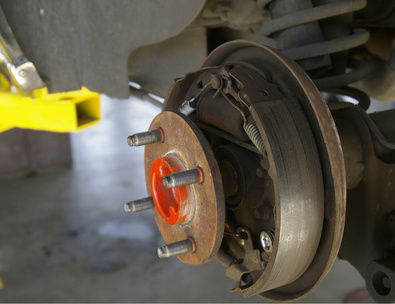
The auto industry website Edmunds suggests changing your front brake pads every 20,000 to 40,000 miles; rear brake pads will need replacement less frequently. But different vehicles -- and different brands of brake pads -- will need pads replaced at different rates. That is why it's so important to be able to diagnose wear patterns on your brake pads in order to know whether they need to be replaced, and whether a problem in the braking system may be wearing them down prematurely.
Examine the brake pads by removing the caliper housing unit that encases the brake. The brake pads will be located between the caliper mounting bolts; the calipers supply the pressure to your wheel's rotor, bringing the vehicle to a stop.
Look for excessive wear on one brake pad but not its pair. This uneven wear pattern may suggest the caliper mounting bolts -- which connect the caliper and hence the brake pads to the rest of the vehicle -- may be unevenly tightened. The website "2 Car Pros" says if your vehicle has a fixed caliper (meaning it has caliper mounting bolts on both sides of the caliper housing unit), look to see which brake pad is excessively worn; this is most likely the side whose mounting bolts are screwed in too tightly. To fix, do not tighten as much when you replace the brake pads.
Examine the brake pads for wear in a "diagonal" pattern (for example, the left brake pad is excessively worn on the top half while the right pad is excessively worn on the bottom). This could suggest the brake caliper mount is defective, applying the pressure diagonally instead of vertically (see Resources section). To repair, the defective brake caliper mount may have to be replaced.
Check for signs of excessive friction on the brake pads. These issues can include cracks, chips or grooves on the brake pads, which suggest too much heat within the brake caliper. 2 Car Pros suggests cleaning the inside of the calipers as well as the rotor before installing replacement pads, as debris on these parts can cause friction. Other parts that apply pressure on the brake pads -- including the caliper mount and mounting bolts -- can also lead to friction if they are installed too tightly or incorrectly, or are worn out.
Look for signs of improper alignment within the braking system. This can involve a "step" in the brake pads, where one section (usually along the border) of both brake pads have not worn while the rest of the brake pad has. This suggests the the brake pads are not coming into correct contact with the rotor. It can be caused by improper installation; make sure brake pads are installed in the exact center of the caliper to avoid this problem. It can also be caused by defective or worn out mounting bolts or calipers, which are not applying even pressure to the pads. The website "Brake & Front End" says that problems with the flex hose, which exerts pressure on the entire braking unit using hydraulic fluid, can also lead to poor alignment and uneven pressure being applied to the brake pads.
Examine the pads to see if they are worn out completely, leaving the rivets exposed. If both pads show this exact same pattern of wear, they have simply seen better days and will need to be replaced. While you're replacing the pads, clean or replace the rotor as well, which might have been damaged by the calipers (which can exert pressure directly on the rotor if the brake pads have worn out).